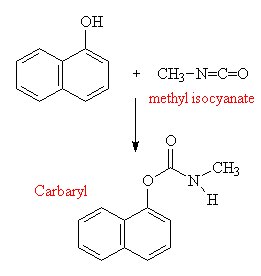
Methyl isocyanate is probably best known, or most notorious, for the deaths it caused in the world's worst ever chemical disaster, which occurred at the Union Carbide works in Bhopal, India. The plant made a very effective insecticide called Carbaryl (also known as Sevin), using a cost-efficient one-step process utilising the highly toxic gas, methyl isocyanate.

It is not known exactly what caused the disaster, but one suggestion is that an operator opened the wrong valve and allowed water to be pumped into the tank of methyl isocyanate. This would have caused a highly exothermic reaction generating CO2, which would have led to a rapid increase in pressure. Whatever the cause, the pressure increase burst a safety disc, releasing the toxic gas. Normally this would not have been too much of a problem, because any toxic gas should have been rendered harmless as it passed through sodium hydroxide 'scrubbers' in the exhaust lines. Unfortunately, on this fateful day the scrubbers were not working and so a deadly cloud of methyl isocyanate was released over the surrounding town.
As a result, over 3,000 people died, and many more thousands were seriously injured. The casualty rate was so high because the chemical plant was located right next to a heavily populated area, and also because company officials treating the victims did not reveal the name of the chemical involved until a few days later - by which time it was too late to properly treat many of the patients.
After extensive negotiations, in 1989 the Indian government, on behalf of the Bhopal victims, accepted Union Carbide's offer of $470 million. However critics have complained that this was far too low, since if the claim had been made in a US court the compensation could have totalled several billion dollars!